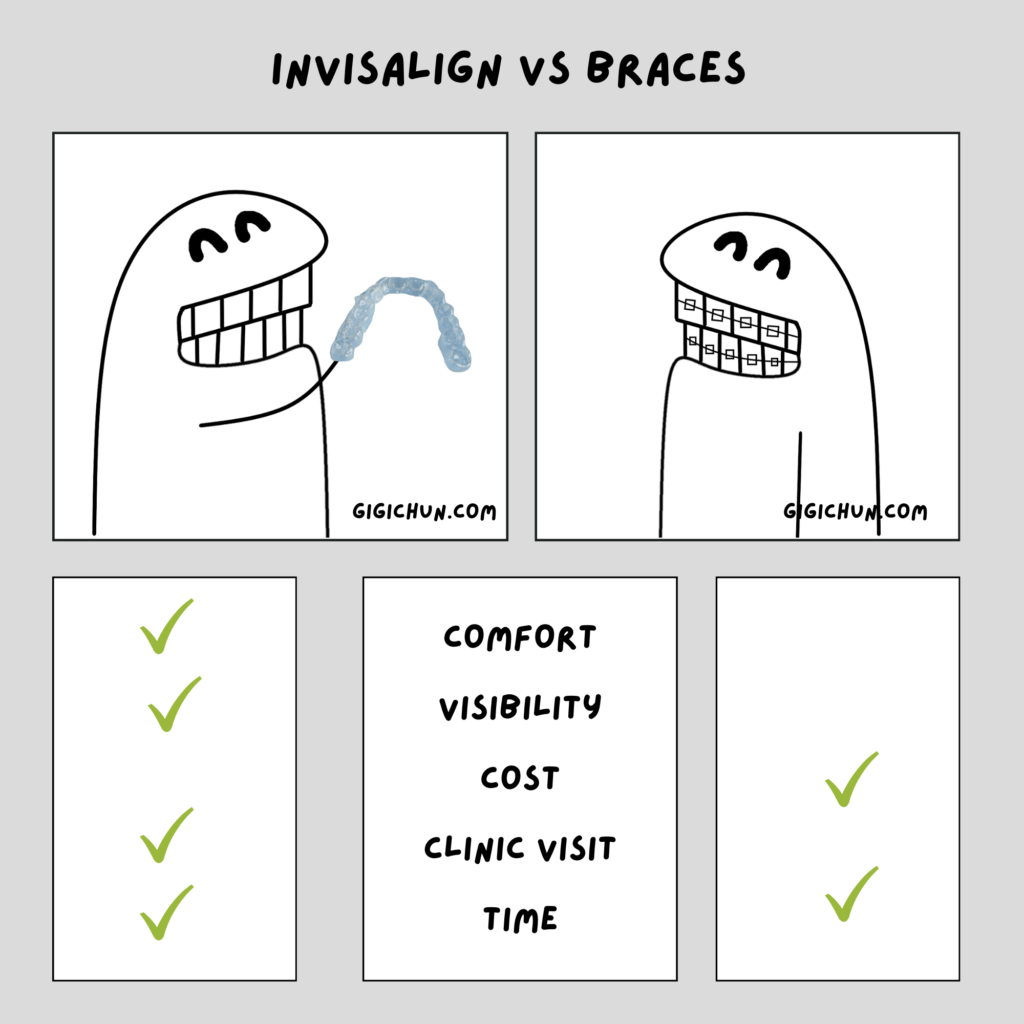Introduction
So you’ve decided to invest in a more fitting smile. That’s awesome! But now you have another decision to make—what form of orthodontics will best fit your lifestyle? Do you go with traditional braces, or opt for something a bit more advanced and discreet like invisalign?
In this article, we’ll take an in-depth look at what sets braces and Invisalign apart from each other. We’ll talk about the different types of braces, how much they cost, whether one particular brand might be better for you than another, and much more. So whether you’re looking for an affordable way to straighten your teeth without anyone knowing, or just want the lowest-cost route available, we’ve got you covered.

Types of Braces: Traditional vs Invisalign
When it comes to straightening your teeth, there are two major options: traditional braces and Invisalign clear aligners. Both solutions can do a great job of transforming your smile and helping you achieve the beautiful results you want!
It’s important to know what each type of orthodontic treatment is to help decide which one is the best fit for you. Traditional braces involve metal brackets being attached to your teeth, while Invisalign clear aligners are made of smooth, comfortable plastic that’s custom-molded to fit your teeth precisely.
Traditional braces tend to be cheaper and require more trips to the orthodontist than Invisalign. However, they also require more maintenance such as regular tightening and create a more noticeable effect. With Invisalign, on the other hand, the aligners slip right on top of your teeth so they’re virtually invisible when worn! You also have access to virtual check-ins with your orthodontist and don’t have any wires or brackets as part of your treatment plan.
Before making a decision, discuss both options with your orthodontist so you can decide which one is right for you based on things like cost, convenience, and comfort level.
Cost of Braces & Invisalign
When it comes to deciding between braces and Invisalign, the cost of each treatment is obviously a factor. Now, the amount you’ll pay will depend on your location and orthodontist. But generally speaking, braces tend to cost less than Invisalign—but the price tag still isn’t cheap.
The total cost of traditional metal braces usually ranges from RM5,000 to over RM9,000. Ceramic or clear braces may be slightly more expensive than metal ones because they’re less noticeable. You can also opt for lingual braces ( attached behind your teeth) , which also can cost more due to their complexity and customization process.
On the other hand, Invisalign costs between RM16,000 and RM25,000. Plus, if you don’t take proper care of your aligners they may need replacement sooner than expected—which means even more money out of pocket.
How to Choose the Right Treatment Plan
Now that you know the difference between braces and Invisalign, you might be wondering how to decide which is the right treatment plan for you?
Weighting the Pros and Cons
The best way to decide is to look at both options, weigh their pros and cons, then make an informed decision.
Braces are typically the least expensive option and have been around for decades. On the flip side, they’re visible and more difficult to keep clean.
Invisalign is usually more expensive than braces but they offer a lot advantages—they’re removable, virtually invisible, and easier to keep clean.
Ask Your Orthodontist For Advice
No one knows your mouth better than your orthodontist. They can provide you with professional advice about what treatment may be best for you based on your personal needs. Plus, they can provide information about cost so that you can make sure it fits into your budget too!
Pros and Cons of Braces & Invisalign
When trying to decide between braces and Invisalign, it’s important to weigh the pros and cons of both. Braces are a more traditional option that provide more precise control— but they can be more awkward than Invisalign. Invisalign tends to cost more than braces—but they are much less conspicuous, meaning you don’t have to worry about the appearance of metal brackets in your mouth.
Braces
The most common type of braces is metal brackets, which secure carefully placed wires with elastic bands. Brackets come in various sizes and shapes, so if you want something discrete there are several options available. The upside is that these braces are typically more affordable than Invisalign.
Invisalign
You’re probably asking yourself a few questions, so be sure to bring them up with your orthodontist. Here are some helpful questions to start with:
How long do I need to wear my braces or Invisalign?
What is the cost of braces or Invisalign?
What is the monthly payment plan like?
Will I need follow-up visits after my treatment is complete?
Are there any special instructions that I need to follow while wearing braces or aligners?
It’s important that you understand the difference between traditional braces and Invisalign, as well as all of the options available. Your orthodontist should be able to provide thorough information about each treatment plan, so you can make an informed decision about what type of braces or Invisalign is best for you.
Conclusion
While both Invisalign and braces can be effective solutions for straightening teeth, deciding which one is right for you will depend on your individual goals and budget. If you’re looking to get the job done quickly, braces may be the better choice. Whereas if you prefer something less visible, Invisalign may be more your style.
No matter which option you choose, your orthodontist can provide you with the information you need to make an informed decision. After all, when it comes to finding the right fit, it’s important to get a clear picture of both braces and Invisalign and ensure that you’re making the best choice for your smile.
In addition to speaking with your orthodontist, it is also a good idea to reach out to people who have already gone through the treatment to ask about their experience. While your orthodontist will be able to provide the technical details of both Invisalign and braces, hearing from someone who has actually gone through the experience can help you gain novel insights and inform your decision. It is also a good idea to make sure you identify any unhealthy habits that you may have, such as grinding your teeth, that could interfere with the effectiveness of either treatment







